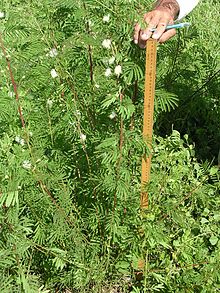- Desmanthus bicornutus
-
Desmanthus bicornutus 
Desmanthus bicornutus Scientific classification Kingdom: Plantae (unranked): Angiosperms (unranked): Eudicots (unranked): Rosids Order: Fabales Family: Fabaceae Subfamily: Mimosoideae Genus: Desmanthus Species: D. bicornutus Binomial name Desmanthus bicornutus
S.WatsonDesmanthus bicornutus (common names Ruby Bundleflower[1], Two-horn Bundleflower[2], and in Mexican Spanish Malvilla de Laguna[3]), is a species of bundleflower endemic to Northern and Central Mexico and the Southwestern United States.[1][2][4] It is an "abundant roadside weed across its native range."[3]
Contents
Description
A small, upright-standing shrub that grows to about 3 meters in height, Desmanthus bicornutus has a woody base. Young stems are often a deep red color; older stems are shiny red or brown. The compound bipinnate leaves are between 9 cm and 18 cm long.
Desmanthus bicornutus blooms in condensed spikes of 25-60 flowers. These flowers may be perfect (occurring apically), functionally male (occurring towards the base of the flower head above the sterile flowers but below the perfect flowers), or sterile. It bears up to a dozen edible linear pods on fruiting stalks up to 5 cm long. Pods are up to 10 cm long and 5.5 mm wide. Immature pods are red but these turn to a dark brown as they mature.[3]
Distribution
Desmanthus bicornutus grows in the states of Baja California Sur, Chihuahua, Sinaloa, and Sonora in Northern Mexico as well as the central states of Colima, Guerrero, Jalisco, Michoacán, Nayarit, and Veracruz.[3] In the United States, D. bicornutus grows naturally only in the state of Arizona.[1]
Ecology
This plant favors clay, rocky, or sandy soils in its native range. At higher elevations, D. bicornutus can be found amid oak forest and in grasslands. At lower elevations, this plant is found near canyons, roads, and waterways.[3]
Though occurring over an area with a wide annual rainfall range (from 300 mm in Arizona to up to 2,000 mm in coastal, southeast Mexico), D. bicornutus is found in areas with intense dry seasons of up to ten months duration.[3] This species typically dies back to its base during winter or dry season and refoliates when conditions become favorable again.[5] It will also regrow in environments ravaged by wildfire.[3]
Use
In Guerrero, Mexico, D. bicornutus beans are used in the making of salsa.[3]
As a component of grasslands in northern Mexico and southern Arizona, D. bicornutus benefits the grazing of livestock and is tolerant of defoliation caused by heavy grazing.[3]
D. bicornutus has been grown experimentally in Australia. Although it grows abundantly as a weed in its native area and may be a potential invasive species, 14-year old experimental plots of D. bicornutus in western Queensland have not overgrown their boundaries.[3] A few cultivars of D. bicornutus have been developed by Texas A&M University.[6]
Bibliography
- Gardiner C.P. and Burt R.L. (1995) "Performance characteristics of Desmanthus virgatus in two contrasting tropical environments". Tropical Grasslands, 29, 183-187.
- Hopkinson, J.M. and English, B.H. (2004) "Germination and hardseededness in Desmanthus". Tropical Grasslands, 38, 1-16.
- Luckow, M. (1993) "Monograph of Desmanthus (Leguminosae-Mimosoideae)". Systematic Botany Monographs. Vol. 38. The American Society of Plant Taxonomists.
- Ocumpaugh, W.R., Grichar W.J., Hussey Jr M.A., Abrameit A.H., Owens, M.K., Reed R.L, Muir J.P., Bade D. and Reilley J.L. (2004) Registration of "BeeTam 06". Crop Science, 44.
- Pengelly, B.C. and Liu, C.J. (2001) "Genetic relationships and variation in the tropical mimosoid legume Desmanthus assessed by random amplified polymorphic DNA". Genetic Resources and Crop Evolution, 48, 91-99.
References
- ^ a b c [1] Arizona Game and Fish Department. 1991. Desmanthus bicornutus. Unpublished abstract compiled and edited by the Heritage Data Management System, Arizona Game and Fish Department, Phoenix, AZ. 3 pp.
- ^ a b [2] USDA natural Resources Conservation Service
- ^ a b c d e f g h i j [3] Tropical Forages
- ^ [4] Texas A&M University Department of Biology Herbarium
- ^ [5] Published in Crop Sci. 44:1859–1860 (2004).
- ^ >[6] "New Forage Varieties for the Southeast" (Proc. 58th Southern Pasture and Forage Crop Improvement Conference, Roanoke, VA June 13, 2004)
Categories:- Mimosoideae
- Flora of Northwestern Mexico
- Flora of Northern Mexico
- Flora of Central Mexico
- Flora of Baja California Sur
- Flora of Arizona
- Flora of Chihuahua
- Flora of Sinaloa
- Flora of Sonora
- Flora of Jalisco
- Flora of Nayarit
- Flora of Colima
- Flora of Guerrero
- Flora of Michoacán
- Flora of Veracruz
- Forages
- Mexican ingredients
Wikimedia Foundation. 2010.
